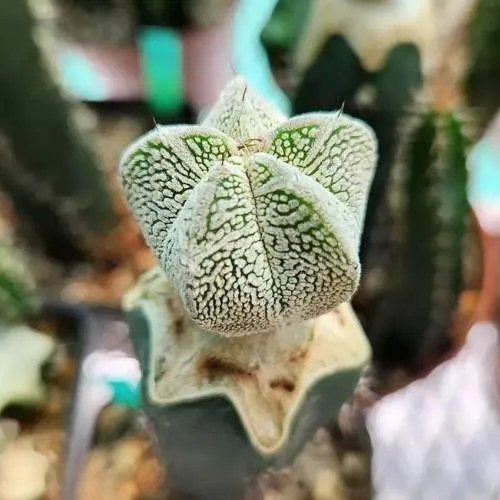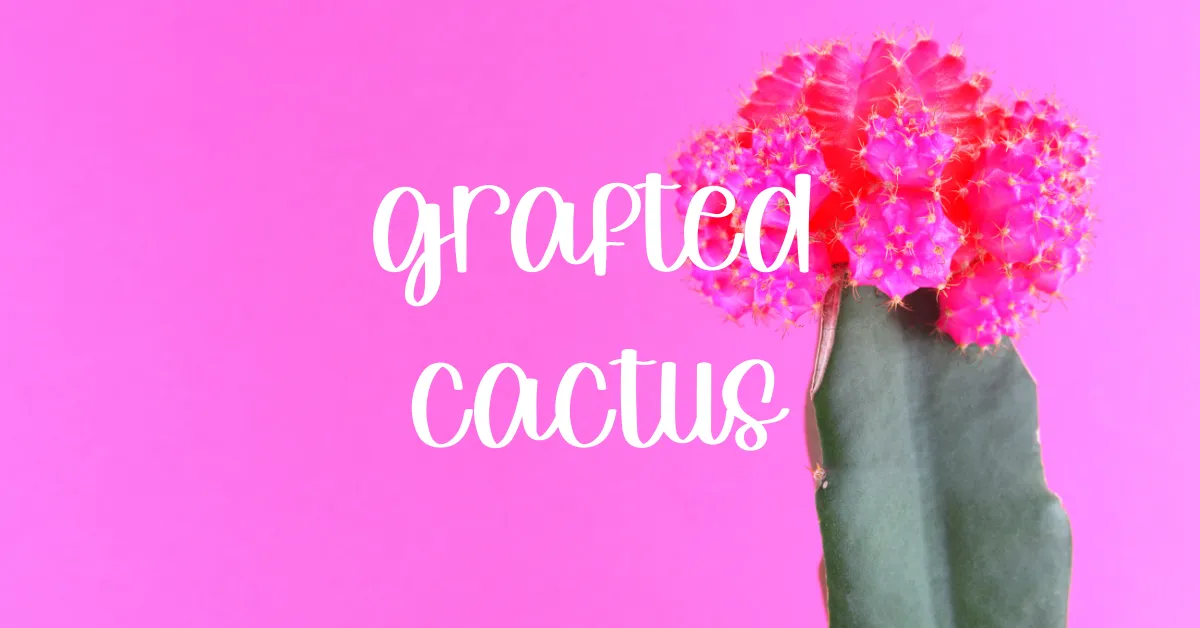Grafted cacti are a type of plant that is created by combining two or more cactus species together. This process is known as grafting and is often used to produce plants with unique or unusual characteristics, such as a particular color or growth habit. In this post, we’ll take a closer look at grafted cacti and explore the benefits and drawbacks of these interesting plants.
Dig in!

• The rootstock: The bottom portion of the cactus that is rooted in soil. A hardy species that is resistant to pests and disease is used as the rootstock.
• The scion: The top portion of the cactus that is grafted onto the rootstock. A more attractive or flowering species is used as the scion. It is grafted onto the rootstock, and they join together as they heal.
What are Grafted Cacti?
Grafted cacti are created by attaching a cutting or “scion” of one cactus species to the root system of another cactus species, known as the “rootstock.” The scion is chosen for its desired characteristics, such as its color, growth habit, or disease resistance, while the rootstock is chosen for its ability to provide a strong, healthy root system. Once grafted, the two cactus species grow together as a single plant, with the scion providing the above-ground growth and the rootstock providing the root system.
Benefits
There are several benefits to grafted cacti. One of the primary benefits is that they can be created with a wide range of desired characteristics, such as a particular color or growth habit. This allows growers to produce plants that may not be possible to achieve through traditional breeding methods. They are also generally more resistant to disease and pests, as the rootstock can provide additional protection to the scion. Additionally, they can be grown faster than non-grafted cacti, as they have access to a mature root system from the start.

Drawbacks
While they have many benefits, there are also some drawbacks to consider. One potential drawback is that they may not be as hardy as non-grafted cacti, as they may be more sensitive to environmental stresses such as drought or cold temperatures. Additionally, they can be more expensive to purchase than regular cacti, due to the cost of the grafting process. Finally, they may not live as long as regular cacti, as the scion may eventually outgrow the rootstock and cause the plant to become unstable.

Here are some additional details about grafted cacti:
• The scion and rootstock must be closely related species for grafting to succeed. They need to be able to join together and share vascular tissues. Typically, species within the same genus are used. The rootstock and scion also must have a similar shape and diameter so they can be joined properly.
• A clean, sharp knife is used to cut both the rootstock and scion into a wedge or slice shape. The vascular tissues of each are then joined together and tied in place with rubber bands or tape while they heal. Keep the graft union in a warm, shady spot as it heals to avoid stress.
• Once the graft union is healed, the cactus can be repotted and cared for as normal. However, take care not to damage the graft union when repotting or handling the cactus. The union can split open or become diseased if damaged or stressed, and the scion portion can die if it loses connection with the rootstock.
• Feed grafted cacti a balanced fertilizer at a lower strength during the growing season. The rootstock and scion have different nutritional needs, so a balanced but diluted fertilizer helps meet the needs of both. Only feed during active growth, and avoid high-nitrogen fertilizers that produce lush growth.

Succulent fertilizer available to purchase on Etsy.
• Inspect grafted cacti regularly for any signs of problems with the graft union or pests/disease on the whole plant. With proper care and monitoring, grafted cacti can provide unique specimens, but they do require more attention to thrive long-term.
As an Amazon Associate I earn from qualifying purchases at no additional cost to you.
Fix the pest problem on your succulents and cacti with these popular insecticides.
Grafted cacti can produce beautiful and intriguing plants, but they are more challenging to care for than non-grafted cacti. With careful repotting, watering, fertilizing, and pest/disease monitoring, grafted cacti can provide unique and eye-catching additions to a succulent collection.
Grafted cacti are a unique and interesting type of plant that is created by combining two or more cactus species together. These plants offer a wide range of benefits, including the ability to produce plants with desired characteristics, increased disease and pest resistance, and faster growth. However, theymay also be more sensitive to environmental stresses and may not live as long as non-grafted cacti.
When considering whether to add a grafted cactus to your collection, it is important to weigh the benefits and drawbacks and consider your own gardening goals and needs. They can be a great addition to any cactus collection, but they may require a bit more care and attention than non-grafted cacti. By understanding the characteristics and care requirements of grafted cacti, you can help ensure that your plants thrive and remain healthy.
Grafted Cactus FAQ
Q: What is a grafted cactus?
A: A grafted cactus is a cactus plant that has been joined together with a piece of another cactus plant, known as the scion. This is done to combine the desirable characteristics of both plants, such as disease resistance or improved growth rate.
Q: How do I care for a grafted cactus?
A: Grafted cacti should be cared for in much the same way as regular cacti, with a few important differences. They should be planted in well-draining soil and placed in a location with bright, indirect light. It’s also important to avoid over-watering, as this can cause the graft to rot.
Q: Can I propagate a grafted cactus?
A: It is not possible to propagate a grafted cactus from cuttings or seeds, as the scion will not grow roots. The only way to propagate a grafted cactus is to take a cutting from the rootstock and graft a new scion onto it.
Q: How long does a grafted cactus live?
A: The life span of a grafted cactus will depend on the species of cactus used as the rootstock and scion. Some cacti can live for decades, while others may only live for a few years. The grafted cactus will typically live as long as the rootstock.
Q: Can I remove the scion from a grafted cactus?
A: It is possible to remove the scion from a grafted cactus, but it is not recommended as it can damage the rootstock. If you want to remove the scion, it is best to wait until the cactus is dormant and carefully cut it away with a sharp knife.
Q: Can I plant a grafted cactus outside?
A: Many grafted cacti can be planted outside in warm, dry climates. However, it is important to acclimate the cactus to outdoor conditions gradually, as sudden changes in temperature and light can be stressful for the plant. It is also important to check the hardiness zone of the cactus to make sure that it can survive the winter temperature in your area.











